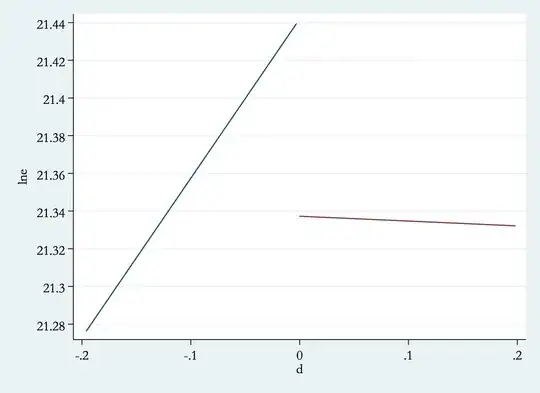I am using the parametric approach and non-parametric (local linear regression) approaches of regression discontinuity design (RDD) to compute the treatment effect using Stata.
To get the user-written rd and the 102nd Congress data, I do this:
net get rd
use votex
The local linear approach:
rd lne d,bw(0.20) mbw(100) ker(rec)
Two variables specified; treatment is
assumed to jump from zero to one at Z=0.
Assignment variable Z is d
Treatment variable X_T unspecified
Outcome variable y is lne
Estimating for bandwidth .2
------------------------------------------------------------------------------
lne | Coef. Std. Err. z P>|z| [95% Conf. Interval]
-------------+----------------------------------------------------------------
lwald | -.1046939 .1147029 -0.91 0.361 -.3295075 .1201197
-----------------------------------------------------------------------------
As far as I understand this is equivalent to following :
gen win_d=win*d
reg lne d win win_d if d>=-0.2 & d<=0.2
Source | SS df MS Number of obs = 267
-------------+------------------------------ F( 3, 263) = 0.43
Model | .271662326 3 .090554109 Prob > F = 0.7339
Residual | 55.7885045 263 .212123591 R-squared = 0.0048
-------------+------------------------------ Adj R-squared = -0.0065
Total | 56.0601668 266 .210752507 Root MSE = .46057
------------------------------------------------------------------------------
lne | Coef. Std. Err. t P>|t| [95% Conf. Interval]
-------------+----------------------------------------------------------------
d | .8450601 .7855123 1.08 0.283 -.7016333 2.391753
win | -.1046939 .1257913 -0.83 0.406 -.3523801 .1429923
win_d | -.8707605 1.048807 -0.83 0.407 -2.935887 1.194366
_cons | 21.44195 .0925378 231.71 0.000 21.25974 21.62415
------------------------------------------------------------------------------
However, when we use the parametric approach (let's say with the polynomial of order one), we use all the observations. But, I am trying to see how parametric approach can be compared with non-parametric approach with the same number of observation as in non-parametric approach. So, I do as follows:
reg lne d win if d>=-0.2 & d<=0.2
Source | SS df MS Number of obs = 267
-------------+------------------------------ F( 2, 264) = 0.30
Model | .125446108 2 .062723054 Prob > F = 0.7440
Residual | 55.9347207 264 .211873942 R-squared = 0.0022
-------------+------------------------------ Adj R-squared = -0.0053
Total | 56.0601668 266 .210752507 Root MSE = .4603
------------------------------------------------------------------------------
lne | Coef. Std. Err. t P>|t| [95% Conf. Interval]
-------------+----------------------------------------------------------------
d | .3566172 .5201877 0.69 0.494 -.6676274 1.380862
win | -.0964314 .1253232 -0.77 0.442 -.3431916 .1503288
_cons | 21.39136 .0696112 307.30 0.000 21.2543 21.52843
------------------------------------------------------------------------------
My concern is why the non-parametric approach result (-.1046939) is not the same as parametric approach (-.0964314), although we are using the same observation for both.
